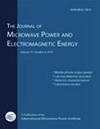Comparison of heating performance between inverter and cycled microwave heating of foods using a coupled multiphysics-kinetic model
IF 1.5
4区 工程技术
Q4 ENGINEERING, CHEMICAL
Journal of Microwave Power and Electromagnetic Energy
Pub Date : 2021-01-02
DOI:10.1080/08327823.2021.1877244
引用次数: 10
Abstract
Abstract Non-uniform heating has been a challenging problem in microwave heating due to ‘standing wave pattern’ and ‘thermal runaway’ problems. Cycled microwave heating was used to improve microwave heating uniformity of frozen products, while a relatively new approach of inverter heating was claimed to help preserve food quality during thawing/heating. In this study, finite-element-method-based coupled multiphysics-kinetic models were developed, validated, and used to investigate these controversial results by comparing the heating performances of average temperature, heating non-uniformity, and nutritional value change between the inverter and cycled microwave heating of foods. The effect of food sizes/shapes and material properties (dielectric loss) was evaluated. Results showed that there was little difference in average temperature, heating uniformity, and Vitamin C content between cycled and inverter heating for different food products. A relatively more uniform heating and lower nutritional value degradation were observed for small size low loss material; however, the improvement was not significant enough to claim the benefit of inverter heating.用多物理场-动力学耦合模型比较逆变器和循环微波加热食品的加热性能
摘要由于“驻波”和“热失控”等问题,微波加热中的非均匀加热一直是一个具有挑战性的问题。循环微波加热被用于提高冷冻产品的微波加热均匀性,而一种相对较新的逆变加热方法被认为有助于在解冻/加热过程中保持食品质量。本研究建立并验证了基于有限元法的耦合多物理场动力学模型,并通过比较逆变器和循环微波加热食物的平均温度、加热不均匀性和营养价值变化等加热性能来研究这些有争议的结果。评估了食物尺寸/形状和材料性能(介电损耗)的影响。结果表明,循环加热和逆变加热对不同食品的平均温度、加热均匀性和维生素C含量差异不大。小尺寸低损耗材料受热相对均匀,营养价值降解较低;然而,这种改善并不显著,不足以声称逆变器加热的好处。
本文章由计算机程序翻译,如有差异,请以英文原文为准。
求助全文
约1分钟内获得全文
求助全文
来源期刊

Journal of Microwave Power and Electromagnetic Energy
ENGINEERING, CHEMICAL-ENGINEERING, ELECTRICAL & ELECTRONIC
CiteScore
2.50
自引率
6.70%
发文量
21
期刊介绍:
The Journal of the Microwave Power Energy (JMPEE) is a quarterly publication of the International Microwave Power Institute (IMPI), aimed to be one of the primary sources of the most reliable information in the arts and sciences of microwave and RF technology. JMPEE provides space to engineers and researchers for presenting papers about non-communication applications of microwave and RF, mostly industrial, scientific, medical and instrumentation. Topics include, but are not limited to: applications in materials science and nanotechnology, characterization of biological tissues, food industry applications, green chemistry, health and therapeutic applications, microwave chemistry, microwave processing of materials, soil remediation, and waste processing.
 求助内容:
求助内容: 应助结果提醒方式:
应助结果提醒方式:


